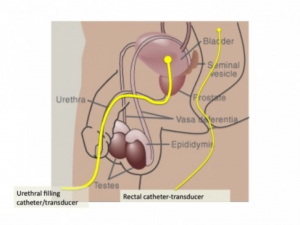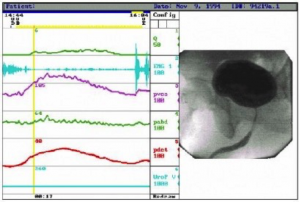“Urodynamic Tests” refer to a series of tests that evaluate the function of your bladder and urethra. In reality you will  undergo one “test” that has a few separate stages.
undergo one “test” that has a few separate stages.
Urodynamics may be recommended if you have urinary incontinence (leakage of urine), recurrent bladder infections, a
slow or weak urinary stream, incomplete bladder emptying, or frequent urination.
Urodynamics tests provide a real-time dynamic assessment of what is going on within your bladder during filling and empting. This allows us to accurately diagnose and treat your urinary problems.
The principle of urodynamics is to measure the pressure in your bladder while it is filling and empting. This is achieved by placing tiny catheters, which contain pressure measuring devices (one in the bladder and one in the rectum) and measuring the pressure difference between them. The pressures are measured in real time during bladder filling and emptying. Tests such as cystoscopy and imaging allow us to see how your bladder is structured and how it physically behaves during filling and emptying.
During urodynamics we want to measure how much your bladder can hold, how much pressure builds up inside your
bladder as it stores urine, and how full it is when you feel the urge to urinate. The doctor will use a catheter to empty your bladder completely. Then a special, smaller catheter will be placed in the bladder. This catheter has a pressure
measuring device within it. Another catheter is placed in the rectum (back passage) to record pressure there as well.

Your bladder will be filled slowly with fluid. During this time you will be asked how your bladder feels and when you feel the need to urinate. The volume of water and the bladder pressure will be recorded. You may be asked to cough or strain during this procedure see if this causes leakage.
When your bladder is feeling full, you will be asked to void and the pressure and flow is measured. This gives us an idea about how strong your bladder is and if there is any obstruction of the flow.
Urodynamic tests may be performed with equipment to take pictures of the bladder during filling and emptying. The imaging equipment may use x rays or ultrasound. If x-ray equipment is used, the bladder will be filled with a contrast
medium that will show up on the x ray instead of the warm water. The pictures and videos show the size and shape of the urinary tract and help your
doctor understand your problem and whether it relates to bladder dysfunction, prostate obstruction or rarely, a problem with co-ordination of the urethral sphincter and bladder (sphincter dyssynergia) which occurs most often in patients with neurological disease or injury.
Overall the risks of the procedure are very small.
You may experience a bit of burning during urination or even a small mount of blood in the urine for a day or two after the procedure.
There is a small risk of urinary tract infection after the procedure.
You will be able to resume all previous activities, including driving, upon completion of the Urodynamics studies.An appointment will be made to discuss the results of the test and make a treatment plan.

A Urodynamic Trace